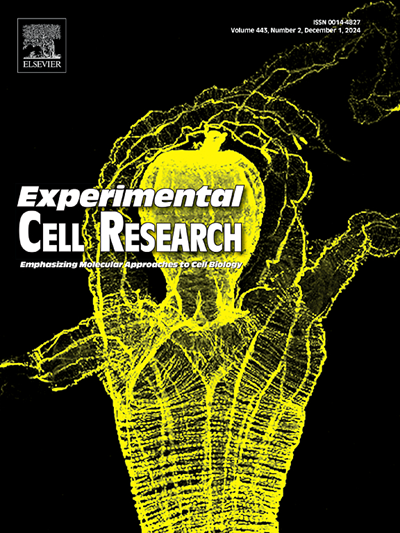雌激素受体激活 SRC 和 ERK1/2,促进人类睾丸胚胎癌细胞 NT2/D1 的肿瘤发生
IF 3.3
3区 生物学
Q3 CELL BIOLOGY
引用次数: 0
摘要
睾丸生殖细胞瘤在年轻男性(15 至 44 岁)中发病率最高,其病因尚不清楚,但它在青春期出现表明这些肿瘤的发生和发展有激素依赖机制。此前,我们在人类睾丸胚胎癌 NT2/D1 细胞中发现了雌激素受体 ESR1、ESR2、GPER 和 ESR1 的异构体 ESR1-36,以及 ESR1 和 ESR2 在这些细胞中诱导的 SRC 激活。因此,本研究旨在分析ER在ERK1/2活化中的作用,以及SRC和ERK1/2对NT2/D1细胞增殖、迁移和侵袭的参与。结果表明,激活 ESR1(使用 ESR1 选择性激动剂 PPT)或 ESR2(使用 ESR2 选择性激动剂 DPN)会增加 NT2/D1 细胞中 ERK1/2 的磷酸化。在 SRC 家族激酶选择性抑制剂 PP2 或 MEK 特异性抑制剂 U0126 的存在下,17β-雌二醇(E2)或 PPT 对 NT2/D1 细胞增殖和侵袭的影响被阻断。最后,PP2 和 U0126 也阻断了 E2 或 ESR2 对 NT2/D1 细胞增殖、迁移和侵袭的模拟作用。这项研究通过证明ER激活了包括SRC和ERK1/2在内的快速反应分子,从而增强了睾丸癌细胞的致瘤潜能,为ER在NT2/D1细胞中的分子机制提供了新的见解。本文章由计算机程序翻译,如有差异,请以英文原文为准。
Estrogen receptor activates SRC and ERK1/2 and promotes tumorigenesis in human testicular embryonic carcinoma cells NT2/D1
Testicular germ cell tumors have the highest incidence in young men (between 15 and 44 years of age) and its etiology is still unclear, but its emergence on puberty suggests a hormone-dependent mechanism for the development of these tumors and their progression. We previously identified the estrogen receptor ESR1, ESR2, GPER and an isoform of ESR1, the ESR1-36 in human testicular embryonic carcinoma NT2/D1 cells, and the activation of SRC induced by ESR1 and ESR2 in these cells. Therefore, this study aimed to analyze the role of ER in the activation of ERK1/2, and the involvement of SRC and ERK1/2 on proliferation, migration, and invasion of the NT2/D1 cells. Our results showed that the activation of ESR1 (using ESR1-selective agonist PPT) or ESR2 (using ESR2-selective agonist DPN) increased phosphorylation of ERK1/2 in NT2/D1 cells. In the presence of the selective inhibitor for SRC-family kinases PP2, or the MEK specific inhibitor U0126, the effects of 17β-estradiol (E2) or PPT were blocked on proliferation and invasion of NT2/D1 cells. Finally, the proliferation, migration, and invasion of NT2/D1 cells simulated by E2 or ESR2 were also blocked by PP2 and U0126. This study provides novel insights into molecular mechanisms of ER in NT2/D1 cells by demonstrating that ER activates rapid responses molecules, including SRC and ERK1/2, which enhance the tumorigenic potential of testicular cancer cells.
求助全文
通过发布文献求助,成功后即可免费获取论文全文。
去求助
来源期刊

Experimental cell research
医学-细胞生物学
CiteScore
7.20
自引率
0.00%
发文量
295
审稿时长
30 days
期刊介绍:
Our scope includes but is not limited to areas such as: Chromosome biology; Chromatin and epigenetics; DNA repair; Gene regulation; Nuclear import-export; RNA processing; Non-coding RNAs; Organelle biology; The cytoskeleton; Intracellular trafficking; Cell-cell and cell-matrix interactions; Cell motility and migration; Cell proliferation; Cellular differentiation; Signal transduction; Programmed cell death.
 求助内容:
求助内容: 应助结果提醒方式:
应助结果提醒方式:


